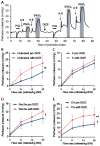Hypoxia-inducible factors activator, roxadustat, increases pulmonary vascular resistance in rats
- PMID: 38165762
- PMCID: PMC10861249
- DOI: 10.33549/physiolres.935220
Hypoxia-inducible factors activator, roxadustat, increases pulmonary vascular resistance in rats
Abstract
Activators of hypoxia inducible factors (HIFs), such as roxadustat, are promising agents for anemia treatment. However, since HIFs are also involved in the regulation of the pulmonary circulation, we hypothesized that roxadustat increases pulmonary vascular resistance and vasoconstrictor reactivity. Using isolated, cell-free solution perfused rat lungs, we found perfusion pressure-flow curves to be shifted to higher pressures by 2 weeks of roxadustat treatment (10 mg/kg every other day), although not as much as by chronic hypoxic exposure. Vasoconstrictor reactivity to angiotensin II and acute hypoxic challenges was not altered by roxadustat. Since roxadustat may inhibit angiotensin-converting enzyme 2 (ACE2), we also tested a purported ACE2 activator, diminazene aceturate (DIZE, 0.1 mM). It produced paradoxical, unexplained pulmonary vasoconstriction. We conclude that the risk of serious pulmonary hypertension is not high when roxadustat is given for 14 days, but monitoring is advisable.
Conflict of interest statement
Figures

Similar articles
-
Chronic hypoxia increases fetoplacental vascular resistance and vasoconstrictor reactivity in the rat.Am J Physiol Heart Circ Physiol. 2008 Apr;294(4):H1638-44. doi: 10.1152/ajpheart.01120.2007. Epub 2008 Feb 29. Am J Physiol Heart Circ Physiol. 2008. PMID: 18310520
-
The beneficial effects of angiotensin-converting enzyme II (ACE2) activator in pulmonary hypertension secondary to left ventricular dysfunction.Int J Med Sci. 2020 Sep 16;17(16):2594-2602. doi: 10.7150/ijms.48096. eCollection 2020. Int J Med Sci. 2020. PMID: 33029102 Free PMC article.
-
The potential actions of angiotensin-converting enzyme II (ACE2) activator diminazene aceturate (DIZE) in various diseases.Clin Exp Pharmacol Physiol. 2020 May;47(5):751-758. doi: 10.1111/1440-1681.13251. Epub 2020 Jan 28. Clin Exp Pharmacol Physiol. 2020. PMID: 31901211 Review.
-
PKCβ and reactive oxygen species mediate enhanced pulmonary vasoconstrictor reactivity following chronic hypoxia in neonatal rats.Am J Physiol Heart Circ Physiol. 2020 Feb 1;318(2):H470-H483. doi: 10.1152/ajpheart.00629.2019. Epub 2020 Jan 10. Am J Physiol Heart Circ Physiol. 2020. PMID: 31922892 Free PMC article.
-
Diminazene Aceturate, an angiotensin converting enzyme 2 (ACE2) activator, promotes cardioprotection in ischemia/reperfusion-induced cardiac injury.Peptides. 2022 May;151:170746. doi: 10.1016/j.peptides.2022.170746. Epub 2022 Jan 13. Peptides. 2022. PMID: 35033621 Review.
Cited by
-
Mechanisms Controlling the Behavior of Vascular Smooth Muscle Cells in Hypoxic Pulmonary Hypertension.Physiol Res. 2024 Nov 29;73(S2):S569-S596. doi: 10.33549/physiolres.935394. Physiol Res. 2024. PMID: 39589304 Free PMC article. Review.
